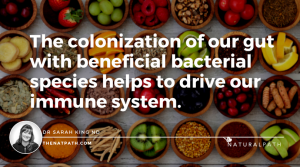Perhaps, delaying exposure shouldn’t be so delayed
 Our former understanding of the outcomes from exposure to allergens early in life has more recently been questioned. Previously, we had thought that delaying exposure to certain substances would help prevent sensitivity and subsequent allergies and illnesses in childhood. However, these guidelines may not be accurate, and instead, may have led to an increase in the incidence of childhood allergies.1,2 Recent evidence indicates that early exposure to microbes may decrease the risk of allergies later in life.3
Our former understanding of the outcomes from exposure to allergens early in life has more recently been questioned. Previously, we had thought that delaying exposure to certain substances would help prevent sensitivity and subsequent allergies and illnesses in childhood. However, these guidelines may not be accurate, and instead, may have led to an increase in the incidence of childhood allergies.1,2 Recent evidence indicates that early exposure to microbes may decrease the risk of allergies later in life.3
Pets and our Immune System
More interestingly is the role that pets play in our immune function from pre-natal maternal exposure, to the first few months of life, and the connection of exposure to colonization of the gut by beneficial bacterial species. This microbiome has demonstrated its role in the development of the immune system and in decreasing the risk of allergies.2
Pet ownership, and exposure to dogs in particular, influences immune function in accordance with the Hygiene Hypothesis. This concept describes how being overly hygienic, and reducing our exposure to certain microbes, can negatively affect our immune function, and lead to an increase in allergies and autoimmune disorders.4
Importance of Intestinal Microbiota
A revision of this hypothesis emphasizes the importance of our intestinal microbiota. For example, antibiotic use, although effective in the treatment of many infectious diseases and illnesses, also wipes out a substantial portion of our gut microbiome. The colonization of our gut with beneficial bacterial species helps to drive our immune system. Specifically, antibiotic use in children reduces the colonization of Bifidobacterium and Lactobacillus strains.4,5 Bifidobacteria, in particular, has been shown to play an important role in the healthy development of infant gut microflora. These species of bacteria shift the immune system and help to balance TH1 and TH2 responses.5 Low levels of Bifidobacteria have been associated with subsequent development of allergic diseases.4 Early, and frequent antibiotic use, has been associated not just with allergies, but also with irritable bowel diseases.5
Many Variables Contribute to Risk of Developing Allergies
There are many different variables that contribute to our risk of developing allergic diseases in childhood including genetics, environmental exposure, age at the time of exposure, the amount of exposure, lifestyle and child-rearing practices.2 Other influences include maternal diet and antibiotic use during pregnancy, and mode of delivery.3
Infants and Allergies
Infants delivered by Caesarian section (CS) have an increased risk of allergic diseases due to the difference in bacterial species they’re exposed to on delivery (vaginal microflora vs. skin microflora). CS-born infants are typically born in more sterile environments compared to those infants who pass through the birth canal.2,3 Vaginal-born infants have also been shown to have higher counts of bacteria in their meconium (first fecal sample) than those delivered by CS.3
The human gut microbiome evolves rapidly in the first few months of life, however, these samples of infant meconium indicate that colonization may start earlier, during gestation.3,4
There is a convincing amount of evidence that our exposure to environmental allergens early in development influences our risk of developing atopic -highly allergic- diseases.2
Previous studies have shown that exposure to farming environments provides a significant protection from the development of allergies and asthma.2,4 Children who grow up or live on farms are exposed to a variety of different microbes and this exposure in inversely associated with the risk of asthma.4 Similar findings have been linked to exposure to house pets (mainly dogs and cats).
Study Reflects Infants Exposed to Pets Less Likely to Develop Some Allergies
One study showed that infants exposed to pets were less likely to develop wheezy bronchitis, allergy symptoms and eczema, compared to non-exposed infants.4 This study also demonstrated that exposure influenced the subsequent composition in gut microbiota, including increased colonization of Bifidobacteria species.
Presence of Dog at Birth Correlates with Reduced Incidence of Wheeze in Some Children
In another study, the presence of a dog at birth correlated to a reduced incidence of wheeze by the age of 3.6 In general, dog owners may have a reduced risk for allergic sensitization which could be attributed to the exposure of domestic endotoxins: molecules found in the membranes of gram-negative bacteria. Exposure to these specific endotoxins elicit the same immunoprotection as those from the exposure of children to farm environments.6
Maternal Exposure and Gestation
It seems that maternal exposure to rich microbial environments, such as farms, leads to an upregulation of genes for the innate immune system in their offspring.7 These modifications in the immune system may start as early as 22 weeks gestation.7
In addition to fecal samples from infants, IgG levels in cord blood has also been used as a predictor of childhood allergen sensitization. Infants whose mothers were pet owners during gestation had significantly reduced levels of IgG in their cord blood and thus a decreased risk of allergen sensitization in childhood.7
Pets can Affect Gut Microbiome
Having pets can affect the gut microbiome, in addition to environmental exposures via dust and soil.2 Though current parenting practices tend to discourage the ingestion of dirt, this in fact may be an important source for establishing a healthy microbiome.2 Even exposure to maternal oral bacteria may be helpful: a more recent recommendation for cleaning a dropped pacifier includes having mom put the pacifier in her mouth first to “clean” it before giving it back to baby.2
Early Exposure to Allergens May be Beneficial
The human microbiome develops rapidly within the first few months of life, and is also likely influenced by maternal environmental exposure during gestation. Allowing exposure to allergens and microbes early in life may be more beneficial for the developing immune system. Recent evidence suggests that having a pet in the house reduces the risk of developing childhood allergic disorders, eczema, and asthma.7 These changes to the guidelines on early allergen exposure may help to prevent the incidence of childhood atopic diseases and support a healthier microbiome.
References:
1. Fletcher, D.M., Spergel, J.M., Assa’ad, A.M., and Pongracic, J.A. “Primary prevention of allergic disease through nutritional interventions” (2013) J Allergy Clin Immunol: In practice 1(1):29-36
2. Gern, J.E. “Promising candidates for allergy prevention” (2015) J Allergy Clin Immunol. 136(1): 23-28
3. Martin, R., Makino, H., Cetinyurek, Y.A., et al. “Early-life events, including mode of delivery and type of feeding, siblings and gender, shape the developing gut microbiota” (2016) PLoS One 11(6): e0158498
4. Nermes, M., Niinivirta, K., Nylund, L., et al. “Perinatal pet exposure, faecal microbiota, and wheezy bronchitis: Is there a connection?” (2013) ISRN Allergy. 2013;827934
5. O’Mahony, S.M., Clarke, G., Borre, Y.E., Dinan, T.G., and Cryan, J.F. “Serotonin, tryptophan metabolism and the brain-gut-microbiome axis” (2015) Beh Brain Res. 277: 32-48
6. Simpson, A. “Effect of household pet ownership on infant immune response and subsequent sensitization” (2010) J Asthma Allergy. 3: 131-7
7. Aichbhaumik, N., Zoratti, E.M, Strickler, R., et al. “Prenatal exposure to household pets influences fetal immunoglobulin E production” (2008) Clin Exp Allergy. 38(11): 131-7
 Dr. Sarah King is a licensed Naturopathic Doctor, graduating from the Canadian College of Naturopathic Medicine in 2014. Prior to completing her medical studies, she attended Nipissing University where she received her Honors Bachelor of Science in Biology. Sarah has a passion for women’s health and is a birth doula in Durham and Toronto Region. She treats a wide variety of health conditions including menstrual disorders and hormone balancing, fertility, prenatal care, digestive concerns, skincare and mental health/anxiety. Outside the office Sarah is an avid runner with a love of the GTA’s best forest trails. She also continues to improve her yoga practice and teaches breath work as part of stress management counseling to her patients.
Dr. Sarah King is a licensed Naturopathic Doctor, graduating from the Canadian College of Naturopathic Medicine in 2014. Prior to completing her medical studies, she attended Nipissing University where she received her Honors Bachelor of Science in Biology. Sarah has a passion for women’s health and is a birth doula in Durham and Toronto Region. She treats a wide variety of health conditions including menstrual disorders and hormone balancing, fertility, prenatal care, digestive concerns, skincare and mental health/anxiety. Outside the office Sarah is an avid runner with a love of the GTA’s best forest trails. She also continues to improve her yoga practice and teaches breath work as part of stress management counseling to her patients.

















